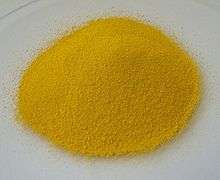Bismuth vanadate
 | |
| Identifiers | |
|---|---|
| ECHA InfoCard | 100.034.439 |
| Properties | |
| BiO4V | |
| Molar mass | 323.92 g·mol−1 |
| Appearance | bright yellow solid |
| Density | 6.1 g/cm3 |
| Refractive index (nD) |
2.45 |
| Except where otherwise noted, data are given for materials in their standard state (at 25 °C [77 °F], 100 kPa). | |
| Infobox references | |
Bismuth vanadate is the inorganic compound with the formula BiVO4. It is a bright yellow solid. It is a representative of "complex inorganic colored pigments," or CICPs. More specifically bismuth vanadate is a mixed-metal oxide. Bismuth vanadate is also known under the Colour Index International as C.I. Pigment Yellow 184.[1] It occurs naturally as the rare minerals pucherite, clinobisvanite, and dreyerite.
History and uses
Bismuth vanadate is a bright yellow powder and may have a slight green tint. When used as a pigment it contains a high Chroma and excellent hiding power. In nature, bismuth vanadate can be found as the mineral pucherite, clinobisvanite, and dreyerite depending on the particular polymorph formed. Its synthesis was first recorded in a pharmaceutical patent in 1924 and began to be used readily as a pigment in the mid-1980s. Today it is manufactured across the world for pigment use.[1]
Properties
Most commercial bismuth vanadate pigments are now based on pure bismuth vanadate with monoclinic (clinobisvanite) or tetragonal (dreyerite) structure though in the past two phase systems involving a 4:3 relationship between bismuth vanadate and bismuth molybdate (Bi2MoO6) have been used.[2] In the monoclinic phase, BiVO4 is an n-type photoactive semiconductor with a bandgap of 2.4 eV, which has been investigated for water splitting after doping with W and Mo.[3] BiVO4 photoanodes have been demonstrated to have a record solar-to-hydrogen conversion efficiency of 5.2% (highest for metal-oxide photo-electrode) with the advantage of a very simple and cheap material.[4][5]
Production
While most CICPs are formed exclusively through solid state, high temperature calcination, bismuth vanadate can be formed from a series of pH controlled precipitation reactions (it is important to note these reactions can be carried out with or without the presence of molybdenum depending on the desired final phase). It is also possible to start with the parent oxides (Bi2O3 and V2O5) and perform a high temperature calcination to achieve a pure product.[6]
References
- 1 2 B. Gunter "Inorganic Colored Pigments” in Ullmann's Encyclopedia of Industrial Chemistry,Wiley-VCH, Weinheim, 2012.
- ↑ G. Kaur, O. P. Pandey, and K. Singh. Optical, structural, and mechanical properties of different valence-cation-doped bismuth vanadate oxides" Phys. Status Solidi A 209, No. 7, 1231–1238 (2012).
- ↑ G. Kaur, O. P. Pandey, and K. Singh. Optical, structural, and mechanical properties of different valence-cation-doped bismuth vanadate oxides" Phys. Status Solidi A 209, No. 7, 1231–1238 (2012).
- ↑ Lihao Han, Fatwa F. Abdi, Roel vandeKrol, Rui Liu, Zhuangqun Huang, Hans-Joachim Lewerenz, Bernard Dam, Miro Zeman, Arno H. M. Smets. ChemSusChem, Volume 7, Issue 10, October 2014, Pages 2832–2838. doi: 10.1002/cssc.20140245
- ↑ Abdi, Fatwa F; Lihao Han; Arno H. M. Smets; Miro Zeman; Bernard Dam; Roel van de Krol (29 July 2013). "Efficient solar water splitting by enhanced charge separation in a bismuth vanadate-silicon tandem photoelectrode". Nature Communications. 4. Bibcode:2013NatCo...4E2195A. doi:10.1038/ncomms3195. Retrieved 5 August 2013.
- ↑ Sulivan, R. European Patent Application 91810033.0, 1991.